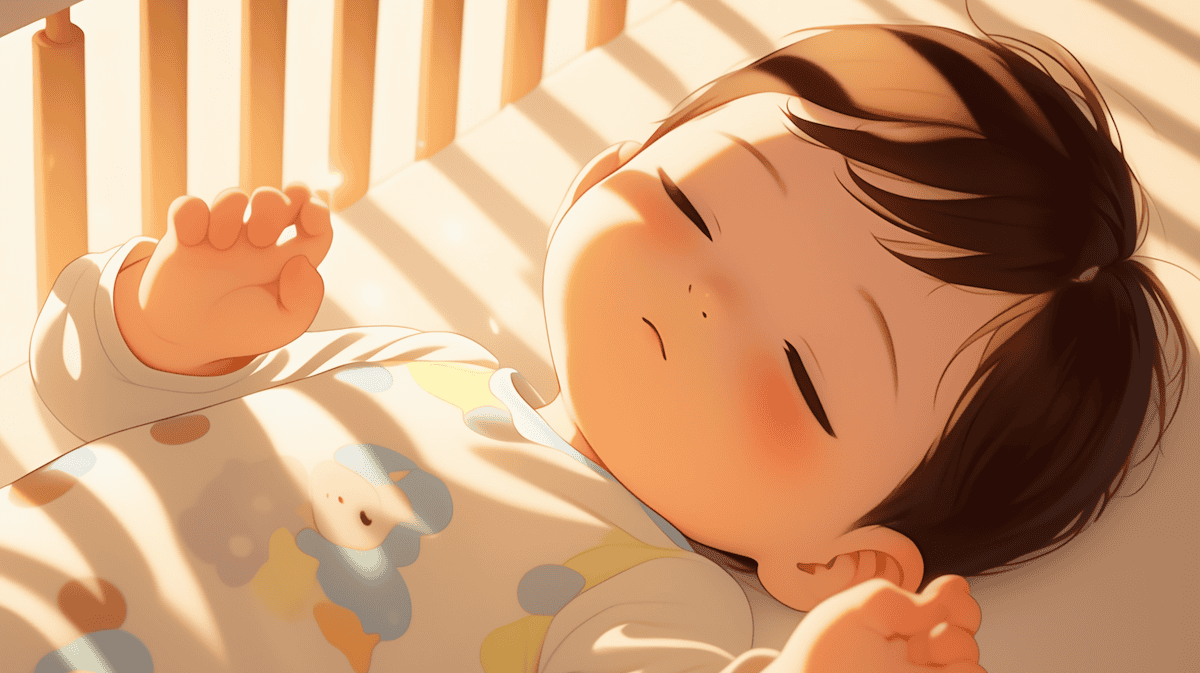Tired of being a detective trying to figure out your baby’s sleep pattern? Like a puzzle with missing pieces, understanding why your little one sleeps the way they do can be a mystery. But don’t worry because in this post we will demystify it and give you practical tips to help your baby establish a healthy sleep routine.
So, let’s get started and uncover the secrets of your baby’s sleep and how you can help them sleep soundly.
Baby Sleep Needs
Babies have different and changing sleep needs. Understanding a baby’s sleep patterns and having a sleep schedule is key to their happiness.
Newborns have short sleep cycles of 40 minutes to a few hours. As they grow, their sleep patterns become more like adult patterns. Following a baby’s circadian clock and having a routine based on their sleep needs is important.
Tracking their sleep patterns helps with this. Naps also play a big role in a baby’s sleep routine. Pay attention to your baby’s behaviour, if they are wakeful and grumpy it may mean they need more sleep, if they are wakeful and happy it may mean they are getting enough rest.
Always consult with your healthcare provider for personalized advice and to ensure a safe sleep environment for your baby.
How Baby Sleep Changes With Age
As your baby grows older, their sleep patterns change a lot, and they become more like adult patterns. Newborns sleep on and off, waking every 1-3 hours for feeding and other needs.
But as they reach 3-6 months, babies start to move towards 2-3 daytime naps. Longer night time sleeps with fewer wakings as they grow older.
Generally, babies sleep better after 12 months, with longer nighttime sleep and less daytime sleep. These changes in sleep patterns are normal parts of sleep development.
Sleep Patterns by Age

Now, let’s talk about sleep patterns by age.
Understanding newborn sleep cycles is key as they have shorter sleep periods and wake up often.
As babies grow older, their sleep patterns change, 3-6 month olds start to sleep longer at night.
Naps also play a big role in having a routine for sleep.
Newborn Sleep Cycles
In the first few months of life, newborns have sleep cycles of frequent wakings due to hunger and other needs. Understanding these sleep patterns will help you navigate this stage with your baby.
Here are some facts about newborn sleep cycles:
- Newborn babies have short sleep cycles of 40 minutes to a few hours. They sleep on and off throughout the day and night, waking every 1-3 hours.
- These frequent wakings are important for their growth and development, they need to be fed and have their other needs met.
- Newborns spend a lot of time in active sleep also known as REM sleep which is important for brain development. But they also have periods of quiet sleep where they are less likely to wake up.
Understanding your baby’s sleep cycle will help you have a routine and provide them a safe and comfortable sleep environment. Sudden infant death syndrome (SIDS) is a concern at this stage so following safe sleep guidelines is key to your baby’s happiness.
Sleep Patterns at 3-6 Months
Understanding your baby’s sleep patterns is key and at 3-6 months they will start to change a lot. Your baby will sleep for 12-15 hours in 24 hours at this stage. They will start to move towards 2-3 daytime naps which will help them get the rest they need.
Night time sleep gets longer, some babies sleep up to 6 hours straight. But remember babies may still wake up at least once at night. As your baby grows, their sleep cycles will have shorter waking periods and will be more like adult sleep patterns.
Having a consistent sleep schedule and bedtime routine is key to sleep readiness and your baby’s healthy sleep habits.
Naps
Naps are important for babies of all ages, it plays a big role in their growth and development. Adequate napping supports attention span, mood, language skills and overall motor development. Having a sleep schedule with regular naps is important for your baby’s overall health and happiness.
Different age groups have different nap requirements so it’s important to know your baby’s needs. By tracking their sleep patterns and observing their mood and behavior you can determine if they are getting enough sleep. Naps also prevent sleep disturbances and promotes a more restful night’s sleep.
Remember to consult a healthcare provider for personalized advice and create a safe sleep environment for your baby. Prioritize naps for their overall development.
Sleep Schedule
To have a sleep schedule for your baby, setting consistent bedtimes and wake times is key. Babies love routine and having a consistent sleep schedule will help them develop healthy sleep habits.
Start by determining the bedtime for your baby based on their age and sleep needs. Newborns sleep shorter and have irregular sleep patterns, but as they grow, they will sleep longer at night.
Create a bedtime routine to signal to your baby that it’s time to wind down and sleep. This can be activities like a warm bath, gentle massage and reading a bedtime story.
Naps and Why They’re Important
Napping is key to your baby’s growth and development. Naps are part of your baby’s sleep routine and overall happiness. Here are three reasons why naps are important:
- Rest and relaxation: Naps give your baby rest and relaxation. During sleep, their bodies can repair and grow, which is important for their development.
- Mood and behaviour: Observe your baby’s mood and behaviour to determine if they are getting enough nap time. If they are wakeful and grumpy, they need more naps. If they are wakeful and happy, it means they are getting enough nap time.
- Brain development: Naps also support your baby’s brain development. Research shows that naps helps in memory consolidation and learning, helps your baby process and retain new information.
Baby Sleep Concerns
Are you worried about your baby’s sleep?
Sleep training can help establish a sleep schedule and routine.
Also, sleep regression phases can help you understand why your baby’s sleep is disrupted at certain times.
Creating a safe sleep environment and bedtime routine can also help you and your baby sleep better.
Sleep Training Techniques
One of the sleep training techniques for babies is the gradual extinction technique, which is to slowly phase out parental soothing to help the baby learn to self soothe and sleep on their own.
As your baby grows you need to establish a bedtime routine to signal to your baby that it’s time to sleep. This can be a warm bath, reading a bedtime story or gentle rocking.
Create a soothing environment with familiar sleep cues like a favorite blanket or soft music to help your baby relax and sleep.
Remember every baby is different, different sleep training techniques may work for some. Be patient and flexible and always consult a healthcare provider for personalized advice.
Sleep Regression Phases
As your baby grows and develops, you need to know the common sleep regression phases that can disrupt their sleep.
Sleep regression phases are common at certain developmental stages like 4 months, 8-10 months and 18 months. During these phases your baby may experience more night waking, difficulty settling for naps and changes in sleep duration. These regressions are often related to cognitive and physical development.
While sleep regressions are temporary, 2-6 weeks, they may require adjustments in soothing techniques or sleep routine. It’s important to provide comfort and reassurance during these phases and maintain a consistent sleep environment to help your baby get back to regular sleep.
Bedtime Routines
To establish a bedtime routine for your baby, do calming activities and create a soothing environment in their room. This will help your baby know it’s time to sleep and develop healthy sleep habit. Try these:
- Start with a warm bath to relax your baby’s muscles and prepare them for sleep.
- Follow the bath with a gentle massage using baby-safe oils, which can be soothing.
Do quiet activities like reading a bedtime story or singing a lullaby to help your baby wind down and associate these activities with sleep.
Safe Sleep Environment
A safe sleep environment is important for your baby’s sleep.
To create a comfortable and safe sleep for your little one, follow these guidelines.
Firstly, always place your baby on their back to reduce the risk of SIDS.
Keep the crib clear of soft bedding, toys and pillows, as they can be a suffocation or entrapment hazard.
Dim and quiet environment using blackout curtains and low noise levels.
Also, dress your baby in sleep clothing to avoid overheating and a firm mattress with a fitted sheet.
Don’t use crib bumpers as they can be a suffocation hazard.
Parent’s Sleep

Parents are affected by their baby’s sleep patterns, which can impact their sleep quality and overall well-being. A baby’s irregular and unpredictable sleep can disrupt a parent’s daily routine and lead to emotional and physical exhaustion.
Waking up to a crying baby all the time can leave parents feeling exhausted and overwhelmed. Trying to adapt and manage their baby’s sleep can also increase stress and anxiety. Focusing and doing daily tasks becomes hard when sleep is fragmented and inconsistent.
Also monitoring and adjusting the baby’s sleep can affect a parent’s mental and emotional wellbeing. Parents need to find support and ways to improve their sleep while understanding and addressing their baby’s sleep needs.
End
Hooray! Now you know and understand your baby’s sleep and can have a sleep routine that will leave you and your little one feeling rested and happy.
With this knowledge of their sleep needs, age related sleep changes and the importance of a sleep schedule you can now navigate the sometimes tricky world of baby sleep.
Go forth and sleep tight and sweet dreams for you and your little one!








